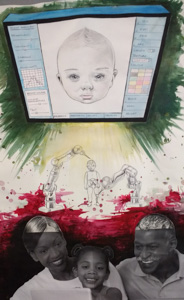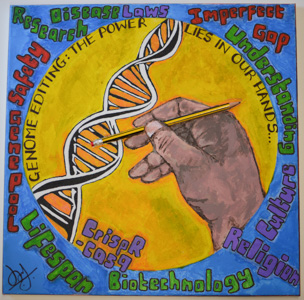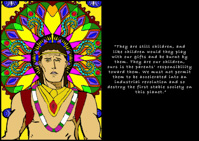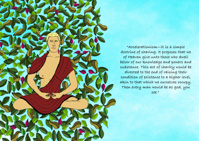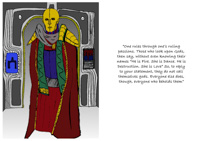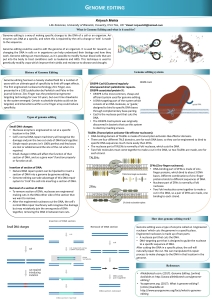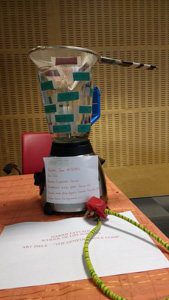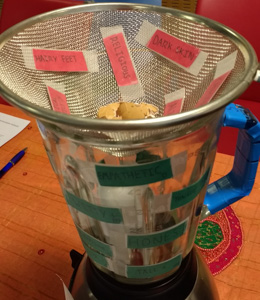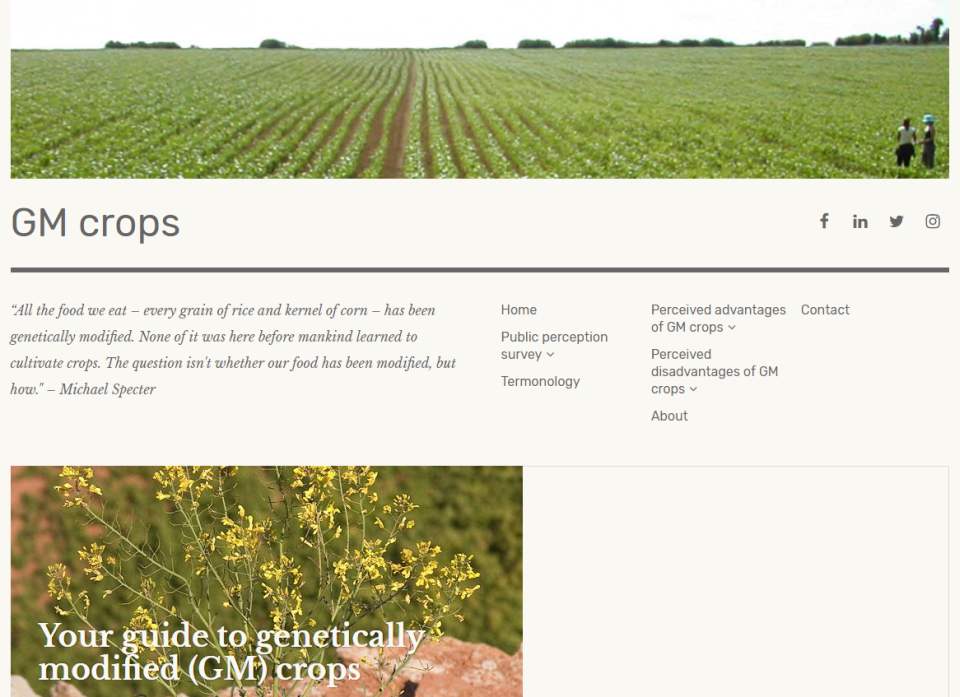'Genetics: Science and Society' Module Exhibition
The 2nd edition of the 'Genetics: Science and Society' Module Exhibition (2018) will take place on the 21st of November in the SU Atrium between 12 and 4 pm. Here a taster of what to expect!
The 2016/17 'Genetics: Science and Society' IATL module exhibition was held in June 2017 in the Library Foyer, University of Warwick.
In this online version of the exhibition, you will find all of the wonderful works that the students produced as part of their Student Devised Assessment (SDA). Enjoy!
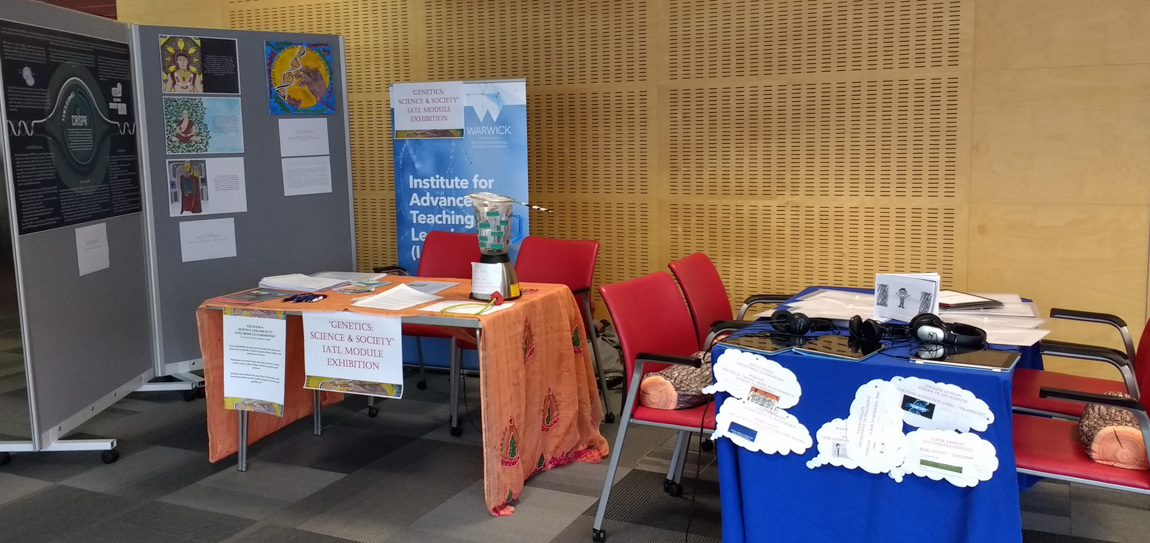
What is a student devised assessment (SDA)?
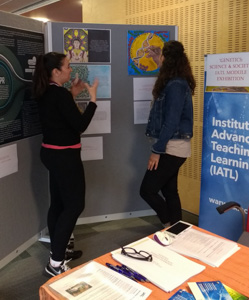
The SDA offers students the chance to display their critical engagement with the themes and theories of the module and to take a considered approach as to how they might practically apply what they have learned in a medium of their choosing.
What does an SDA look like?
The SDA's form is down to the student. They consider what issues and theories they want to address and then pick whatever form they feel best expresses them.
They start by thinking of the key question they would like to investigate or explore in their SDA and then they choose how to develop their research and the medium with which they would like to communicate their findings.
The SDA can take any form they wish (a story, workshop, presentation, blog, comic, painting, video, essay, dance, website, poem, song, learning resource, collage, diary...anything!) and it displays their personal experiences of and thoughts about the module’s topics, questions, and stimuli in the best way possible. They have to clearly demonstrate and critically engage with theory and give an explanation of their choice of medium. To help with this, they write an accompanying explanation or give an accompanying presentation to their piece together with a detailed bibliography.
In this exhibition, you will be able to explore all the SDAs of the students introduced by a short blurb extrapolated from their accompanying piece.
Emily Cooper, School of Life Sciences
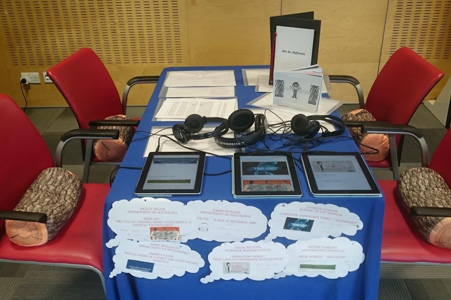
‘Genetics-based films and novels often portray the pursuit of genetic modification as something dangerous and inherently evil. In my devised piece, I wanted to challenge this trope; this dystopian world was birthed from the rejection of advances in genetics. A reluctance to trust science has led to the population losing its autonomy; to a society where humans are treated like livestock, and babies are an infinite resource.’
‘I decided to write a short story; I wanted to combine the science of genetics with an emotive, personal account of a woman affected by it.’
‘The ‘slippery slope’ argument makes the point that permitting genetic engineering may lead to a snowball effect; how can we guarantee that authorising one form won’t lead to genetic enhancement becoming commonplace? In 2013, King made the claim that “Once we've crossed this crucial ethical line…it becomes very difficult to then stop”. Do we have a responsibility to pursue genetic modification in order to secure the genetic health of the population, or will this lead to a society obsessed with perfection? Although these questions will not be easily answered, my story aims to encourage a discussion about the future of genetic modification, and the role it plays in modern society.’
Govan Rashid, School of Life Sciences
Art piece – painting
‘I have created this piece of art with the aim of making the audience aware of the fact that we are moving towards times of exponential technological and scientific advancement such as genetic engineering. Genetic engineering has a huge potential of preventing life limiting disorders, as well as increasing the life span of individuals, simply through altering our genomes. However, with such advancement, there’s always the risk to take the extra step and cross the line between what is ethically right and wrong.’
‘A huge worry amongst many is the misuse of genetic engineering to ‘design’ people’s own babies in the future. I wanted to use my art to communicate how genetic engineering has a chance of being misused in future, taking the natural beauty of individuality away from our community for a more aesthetically pleasing ‘fake’ beauty. This is especially a worry in today’s society, where there seems to be a positive correlation between your beauty and talent, and societal status.’
‘I chose for the family creating the baby to be black-African with dark skin, and for the baby to be European looking. This is in order to show the potential extremes that people may go to.’
Michael Le Guillou, Department of Economics
![]() Creative piece – “Not So Different"
Creative piece – “Not So Different"
‘This creative writing piece attempts to demonstrate some of the concepts learnt during my interdisciplinary journey over the last term. It is intended to be in the style of a first chapter and uses the setting of a dystopian future to showcase some of the social issues associated with genetic engineering technology, and the implications such techniques could have if pushed to their most negative extreme.’
‘The piece has been strongly influenced by the film GATTACA (1997), and Kirby’s (2007) writings about the fact it showcases genetic discrimination and homogenization. I have tried to show this in the piece, taking it one step further by creating future legislation causing saviour siblings and unenhanced humans to be legally seen as second-rate citizens.’
‘There are several themes from the course I have attempted to include, symbolised by certain actions/stylistic features the characters have been given.’
Thoqeer Hussain, School of Life Sciences
Animation video: "Frameshift"
‘I intended to create a narrative for the general public which outlines the dangers linked to genetic research which are normally overlooked. I wanted to present a solution to this, by highlighting how public engagement with scientists can influence research to be guided by caution and transparency. I also had a tertiary aim of showing how genetics is linked to other disciplines.’
‘After reading that the brain processes visuals 60,000 times faster than it does text and how the brain appears more engaged when something is presented as a story, I was influenced to create a cartoon animation which would also complement today’s social media platforms.’
‘I named my piece “Frameshift”, which has an underlying meaning. A frameshift mutation is caused by the insertion or deletion of nucleotides in a DNA sequence which changes the entire reading frame of the genetic sequence post alteration. I feel a frameshift mutation is a microcosm of modern society since the acquisition of genetic knowledge (like the insertion of a nucleotide) has completely altered society from its discovery.’
‘The protagonist time-travels to see the structure of DNA being discovered and then the animation continues with the character travelling to the future.’
Melissa Still, English and Comparative Literary Studies
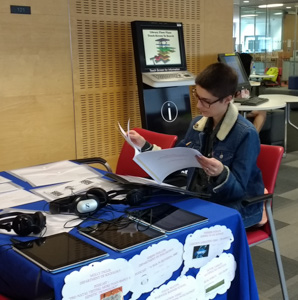
![]() Creative piece – ‘The Genetic Elevation Project’
Creative piece – ‘The Genetic Elevation Project’
‘I wanted to write a Sci-Fi story which presented a scientific utopia, but a societal dystopia. Sci-Fi literature has a huge role in determining the way in which science is thought of by the general public. I am fascinated by the ways in which science is often depicted in the literary world. These pieces of fiction are often used to warn society, and offer a moral or ethical commentary on science and a future that has not been developed yet.’
‘I gained inspiration from the most renown novel concerning the dangers of the progression of science: Frankenstein. Frankenstein is an epistolary novel; therefore, I thought it was fitting to use a similar letter form for my SDA. Shelley’s text rarely makes reference to extensive or realistic science. Nonetheless, the general public is still afraid of scientific advances due to concerns over the mere imaginary notion of a Frankensteinian future or creature. By using a similar form as Frankenstein, I attempt to raise questions concerning the power assigned to such forms of literature. I presented a negative future with abstract scientific themes as a backdrop. This simple technique allows me to influence someone and perhaps make them view modern science negatively; similarly to what is already done in a large percentage of Sci-Fi literature.’
Hugh Murphy, School of Life Sciences
![]() Essay – “To what extent does societal ignorance contribute to conflict over Reprogenetics?”
Essay – “To what extent does societal ignorance contribute to conflict over Reprogenetics?”
‘Public conflict over reprogenetics has been around for a long time, taking many forms including marches, protests, and anger towards policy decisions. The importance of this debate is mounting as genetic technologies advance rapidly, enabling genetic interventions that were not possible a decade ago.’
‘As progressions in reprogenetic technology become increasingly frequent, so should the urgency ascribed to a transparent public dialogue aimed at augmenting public understanding of reprogenetic technology. While there are many varied causes of societal ignorance, I argue that misleading media portrayal of science, coupled with scientists not conveying the research effectively are the major contributors. Therefore, societal ignorance is a major contributor to conflict over reprogenetics, but responsibility cannot be assigned exclusively to the public – it must be a duty for the scientists to help address the issue. I believe that there will always be a conflict of some scale over reprogenetics, but I imagine that if there was a greater public understanding, some of these conflicts could be lessened.’
Molly Inglis, Department of Sociology
Podcast: "Pre-natal testing; more than simply a genetic technology"
‘I chose to do a podcast for a couple of reasons, firstly I liked the creativity it allowed me, combining both spoken word and images to communicate my research on the topic. Secondly, I like how accessible a podcast is, by this I mean that I wished to make what are fairly complicated terms as easily understandable as possible. The intended audience for my podcast is based on the class, university students from any background who may have an interest in the relationship between genetics and society.’
‘My aim for my podcast was for it to be a journey, transitioning between disciplines and theories to try to explore the various perspectives on pre-natal testing, with a focus primarily on Down Syndrome as this is a common genetic condition that is tested for in pregnancy.’
‘I have not aimed to be pro pre-natal testing nor have I wished to take a bias against it, rather I have intended to demonstrate its complexity, highlighting the various viewpoints around the topic and therefore allowing the listener to make an informed opinion on pre-natal testing.’
Rosie Clarke, Department of Film and Television Studies
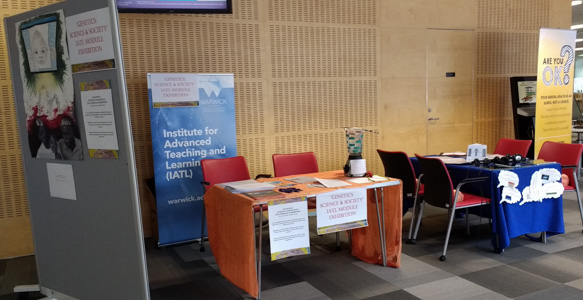
![]() Reflective Piece – collection of blogs
Reflective Piece – collection of blogs
‘This Student Devised Assessment is aimed at university students and anyone interested in the topics. It will consist of 5 blog-style reflection reports and it will explore points raised in seminars. I would like to invite critical reflection upon these topics that are not often represented in popular media and explore the interdisciplinary nature of genetic research.’
‘The consideration of critical theory is vital to further understand and critique policies and why they are put in place.
This is something that, I believe, is not explored enough and so I hope that the critical reflection encouraged in this piece invites deconstruction and analysis of research and topics and inventions that are happening all the time in the 21st century, and to be engaged with the consequential implications about these issues, and what it suggests about culture, prejudices, and preconceptions, and how to critically evaluate them in society.’
Manveer Singh Athwal, School of Life Sciences
‘I produced a poster on genetic engineering and genome editing techniques. I decided to focus on the CRISPR gene editing system as it has revolutionised the field of genome editing and has gained much media attention. During the module, I realised that concepts that seemed simple to me, a biomedical science student, were in fact completely alien to others who do not come from a scientific background. Therefore, this poster is aimed to educate adults of the general public. It could also be used to introduce this technology to young adults such as those doing their A-levels.’
‘I tried to list those studies that I thought would intrigue the audience the most and spark the most interest.’
‘I ended with some questions about CRIPSR. I did this so that the reader could develop their own viewpoint on the issue. I also tried to present a balanced argument for and against the uses of the technology. A poster does not give all information about the issues. I did not want to force a view point upon the reader, but, as stated wanted them to go away and do further research themselves and come to a conclusion themselves.’
Jahazaib Johngir, School of Life Sciences
Art piece - Painting – “Genome-Editing: The Power Lies in Our Hands…”
‘Genome Editing is the theme for my SDA. What I want to achieve with my SDA is to give an artist’s impression of the ethical argument of genome editing and the final thought of “the power lies in our hands” to make the decision, is genome editing good or bad? The use of this painting is to drive a debate on the topic of genome editing and the potential advantages and disadvantages.’
‘The aim of this painting is to give a simplified artists’ impression of what genome editing looks like; the hand is my hand to represent that it was humans’ that invented the technology. The pencil is the tool we humans can use to edit and create things, whether it be a drawing, painting or piece of writing. The sequence that is drawn next to the hand is a representation of a DNA sequence. The DNA sequence I have drawn is completed but has a break in the strand where the end of the pencil with the rubber touches the sequence, this is to represent the editing that is taking place by the pencil which is being held by the hand. The purpose of this painting is to be used as a debating tool to prompt discussion, therefore I additionally added ![]() keywords around the image and added a title to drive or prompt a debate.’
keywords around the image and added a title to drive or prompt a debate.’
Egal Igeh, School of Life Sciences
![]() Essay – “The case against Genetic Editing”
Essay – “The case against Genetic Editing”
‘CRISPR –Cas9 is a genome editing tool generating much debate and controversy in the scientific world due to its wide range of potential applications. In this essay, I will present the most common arguments against the introduction of genetic editing in human embryos and how, in my opinion, it will do more harm than good in the long term.’
‘There is no question, with regards to somatic genetic editing, that treating a diseased individual is of overall benefit. But the slippery slope argument can be applied as to where the line would be drawn. [...] You can either place barriers, governed by laws and policies, or shift your moral framework to accommodate the new reality.’
‘Ethical questions surrounding the use of this new genetic editing tool need to be considered now and requires interdisciplinary work with academics from all backgrounds as well as the public as it is an issue that will affect everyone. Increased awareness is needed on all fronts as the need for an informed decision is crucial. This can first be done by addressing the unease of the public by forming bridges and modes of communication between them and the scientists involved in the research.’
Aimee Singleton, Department of Psychology
Presentation: "Social Media is a Force for Good Within Genetics"
‘Social Media has been largely adopted in people’s personal lives. It is a power tool of communication and is increasingly being used for fact checking. Considering this, I was interested in exploring the link between genetics and social media.’
‘Social media could improve public knowledge about topics and research, allow researchers to showcase their findings to a wider audience and help classroom teaching. For example, social media could help genetic counsellors communicate with patients and improve patient knowledge of genetic diseases.’
‘I wanted to communicate this message to my target audience [people in the genetics profession] and persuade them that social media should be used. There was a need for this since in 2016 social media was still not being used in this field.’
Audio file
Slides
Alex Janner, School of Life Sciences
Art piece - Drawings – “Lord of Light"
‘The aim of my student devised assessment is to present some older science-fiction in a manner which would foster interest among the wider public and hopefully encourage them to engage with it.’
‘One of my favourite science-fiction books, and one which explores the concept of science, genetics, and society extensively, is Lord of Light by Robert Zelazny. Written in 1967, during a time of great public hysteria over the role of science and sense of dread over the future, it combines esoteric Hindu mythology and philosophy with an inspired take on the future. Similarly to Gattaca, it presents a world where the potential of genetic engineering and scientific advancement has been fully realised, but restricted to a chosen few.
‘For my SDA, I decided to draw characters from the book – Brahma, Sam, and Yama – based on their descriptions. The aim of my SDA is to generate interest in the book, but also the ideas within them. Therefore, I took quotes from the book itself, related to the subject of science and society, and drew the characters as I imagined them speaking.’
Gloria Chan, Department of Film and Television Studies
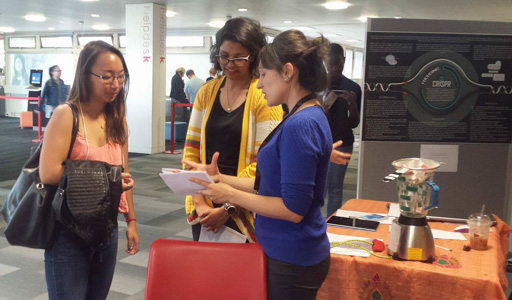
‘I decided to create a book called ‘Who Am I?’ that aims to explain the basis of genetics to kids aged 5 to 7 in order to start to present crucial concepts for their future understanding of all organisms.’
‘Nodelman’s argument (2008) about not setting limitations in children books influenced me to attempt to introduce genetics to kids 5-7. My book wants to act as a simple springboard for their initial understanding of what genetics is.’
‘My book has managed to integrate the fun part of language, such as saying DNA together with Dr Science, with genetics. It also incorporates 3D elements as for examples a simplified structure of the DNA double helix so that the child will not be easily bored.
These choices echo the strategies adopted by several scholars and book writers that managed to be successful in teaching science to very young children.’
Halia Nguyen, Warwick Business School
Animation video: "Does genetics determine intelligence?"
‘Intelligence is a complex trait to study because it could be defined and measured in different ways. Many studies rely on a measure called IQ (intelligence quotient).’
‘Studies that focus on similarities and differences in IQ within families members suggest that genetic factors underlie about 50% of the difference in intelligence among individuals (GHR 2015; Sukel 2017)’
‘Genetics is the science of inheritance, not pre-determinism, and there is no substitute for hard work and application. (Griffin 2015)’
‘In the real world there is not the nature vs nurture argument, only an infinitely complex moment-by-moment interaction between genetic and environmental factors.’
Joseph Phillips, Department of Philosophy
Podcast: "A Bar In Bethesda, 1998"
‘The scene takes place in the year 1998, in a Washington bar somewhere between NIH clinical centre and Celera Corporation. We find sat at a table together Ray and David, two former colleagues who were working together on the Human Genome Project (HGP) under a government team. But Ray has since left to work at Celera under Craig Venter (now infamous in the biotech industry).’
‘Their conversation deals with some of the conflicts between the states international effort to sequence the genome and the private efforts that sprung up in response to this. The two characters are fictional, but the points they raise reflect the attitudes expressed by Craig Venter, Francis Collins, James Watson, other employees, investors and scientists involved in both projects, the popular press and the critical literature written around the time (1990 – 2000).’
‘The play does not provide a resolution to the discussed difficulties, but rather provides a portrait of how politics, public opinion, personal ambition and economic contingencies all played a role in the race to sequence the human genome.’
William Tall, School of Life Sciences
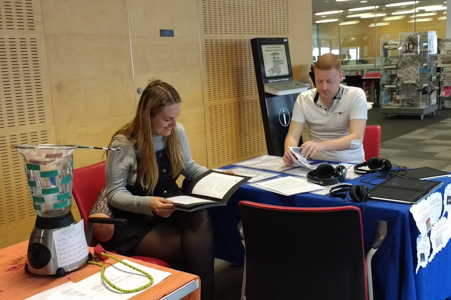
![]() Essay – “Genetics – the Slippery Slope to Eugenics ?”
Essay – “Genetics – the Slippery Slope to Eugenics ?”
'Genetics is a highly topical and debated field owing to the potential benefits and risks that come with it. One of the main arguments against genetics is the slippery slope argument.
To ensure the prevention of a GATTACA-esque dystopia, legislation needs to be put in place to formalise the ownership of genetic information.’
‘The nature of a slippery slope argument is that there is a point at which the agent loses control, as explained by the loss of control premise. I would argue that developments such as mitochondrial donation have not yet reached that point and so society still has control over the progression of genetics. In order to make sure that the point of loss of control is not reached, genetic ownership needs to be formalised in the form of legislation to enable the benefits of genetic studies without compromising the right of the individual to genetic privacy.’
Kriyesh Mehta, School of Life Sciences
Poster– “Genome Editing”
‘My aim/goal of doing a poster on this topic is because I believe it is very important to fully understand how human genome impacts on human biology.
The reason why I chose this SDA was that I realised that whilst studying the ‘Genetics: Science and Society’ module, many of the non-scientific students didn’t know the basics of genetics. Hence this is why I chose the topic of ‘Genome Editing’, to build the knowledge of people who aren’t from a scientific background.’
‘Scientists communicating to the public is crucial, as there are more advances in individual genome sequencing and the introduction of new medicine. Non-scientists will need to be comfortable with scientific information to take decisions that affect their quality of life.’
‘This poster has the key elements of genomic editing and so should be easy to understand and follow, so it is suitable for most ages, mainly for young adults and over.’
Darius Fattahi, School of Life Sciences
Art Piece – “The Genetic Sauce Code”
‘While genetic editing and the creation of ‘designer babies’ is currently possible via methods such as CRSIPR/Cas9, it is currently illegal to create a baby in the UK, for myriads of reasons.
I attempt to portray some of these reasons via my SDA.’
‘My project symbolises a designer baby that a set of parents have ‘ordered’.’
‘What can be observed, is a jug with a sieve in it. There are green pieces of card stuck on the jug, and red pieces stuck on the sieve. Written on these pieces of card, are traits. The green ones being the desirable ones, and the red ones being the traits that are literally being filtered out.’
For a full and detailed explanation of all the parts of the ‘Genetic Blender’, please read the ![]() ‘Blender instructions’.
‘Blender instructions’.
Oliver Tarrant, Warwick Mathematics Institute
Blog website: "GM crops"
‘Throughout the module, I have been fascinated by the wide range of ethical issues being raised regarding the use of human genetic technologies. I personally have a specific interest in the natural world around us. To reflect this I have decided to focus my SDA on researching the use of genetic technologies in the world of agriculture and in particular, the technologies and issues associated with genetically modified (GM) crops.’
‘I have heard very mixed messages about GM crops from various sources throughout my life. From what I can tell, most people will be in a similar situation to me.
It was discussed in lectures how as our technologies continue to progress, society will have a greater role in moderating how we use them. To do this responsibly, I believe that the public needs to be better informed about which and how genetic technologies are used in crops and how much truth there is in the associated stigmas. To address this issue, I have decided to dedicate my SDA to the production of a blog website which will be a public information resource for GM crops.’

